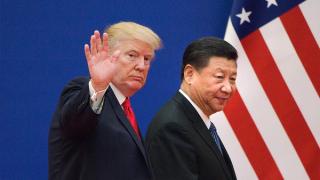As COVID-19 ravages the United States and China rolls out medical supplies around the world, it's become easy to paint the pandemic as a turning point in the US-China struggle for global influence and leadership.
This interpretation is not without some merit.
From denial and inaction to overwhelmed hospitals and mass graves, President Donald Trump's bungled domestic response to the pandemic has crippled America's international standing and left it missing in action on the global stage.
China, for its part, is moving fast to fill the leadership void.
From denial and inaction to overwhelmed hospitals and mass graves, President Donald Trump's bungled domestic response to the pandemic has crippled America's international standing and left it missing in action on the global stage.
Despite its culpability and cover-ups at the start of the pandemic, Beijing is exporting testing kits, ventilators and protective equipment to those in critical need — including New York City — alongside a strident, if ham-fisted, public relations campaign portraying itself as a benevolent and capable global citizen.
The reality, however, is disappointing: the coronavirus has exposed the fact that neither the US nor China is sufficiently equipped for global health leadership at this time of international need.
A series of short-sighted, albeit quite different, domestic political failings are to blame. Both should have done better.
Cover-ups and mishandling in China
After mishandling the Severe Acute Respiratory Syndrome (SARS) outbreak in 2002, Beijing vowed to improve its public health operations in order to prevent and contain viral pandemics.
Like COVID-19, SARS was a novel coronavirus originating in China that leapt from animals to humans in the unsanitary conditions of one of China's wildlife markets.
It was also initially covered up by provincial Chinese authorities — going on to kill 800 people and infect 8,000 more in 26 countries. It also knocked at least 1 per cent off China's GDP that year.
The coronavirus has exposed the fact that neither the US nor China is sufficiently equipped for global health leadership at this time of international need.
Beijing eventually came clean and took genuine steps to improve its performance. It invested over US$800 million to improve China's nascent disease control and prevention infrastructure.
It directed its Center for Disease Control (CDC) to cooperate with America's CDC on improving China's capacity for virology, epidemiology, influenza surveillance and pandemic response.
It even established what US experts have labelled a "world-class" National Influenza Center and an office of global health within its CDC.
These reforms served China — and the world — well during the avian influenza outbreaks of 2009 and 2013, and enabled Beijing to mount a small but impressive international response to the Ebola pandemic in Africa in 2012-16.
But more recent Chinese efforts have languished.
According to RAND Corporation epidemiologist Jennifer Bouey, the "growing public health needs" of 1.4 billion people have "stretched the still-limited investments in China's public health and [pandemic] preparedness and response."
China's CDC is especially vulnerable: straining under "dwindling funding", unable to hire or retain top health professionals, and plagued by poor coordination and "inconsistent data sharing" between domestic health and policy agencies.
What of the United States?
Above all, Beijing has not solved the key regulatory problem at the heart of SARS and COVID-19.
It remains effectively illegal for any doctor, health worker or provincial official to release "information" on an infectious diseases emergency until this data is transferred, reviewed and announced by the Ministry of Health.
This deliberately opaque process — coupled with Beijing's lies about the infection rate and death toll of COVID-19 — have compounded the problems of China's developing but overstrained public health system.
It leaves the country ill-equipped for global health leadership, despite its impressive after-the-fact COVID-19 lockdown and global provision of medical supplies.
While America's Center for Disease Control and inter-agency ecosystem of public health experts are global leaders, the federal government's capacity to prevent and manage pandemics has atrophied in the face of resource constraints.
What, then, of the United States — the world's traditional leader in pandemic responses and cutting-edge infectious diseases control?
While America's Center for Disease Control and inter-agency ecosystem of public health experts are global leaders, the federal government's capacity to prevent and manage pandemics has atrophied in the face of resource constraints.
As recently as January 2019, the Trump administration's then-Director of National Intelligence Dan Coats cautioned:
the United States and the world will remain vulnerable to the next flu pandemic or largescale outbreak of a contagious disease that could lead to massive rates of death and disability, severely affect the world economy, strain international resources, and increase calls on the United States for support.
Yet President Trump has consistently proposed deep budget cuts to the agencies and departments that contribute to America's pandemic preparedness at home and abroad.
Reductions to the CDC's funding for work on emerging and zoonotic infectious diseases — including coronaviruses like COVID-19 — have been especially myopic.
These programs have been targeted for annual cost-saving measures in every budget since Trump took office, with proposed cuts of $61.7 million in 2018, $96.4 million in 2019, $114.4 million in 2020 and $85.3 million in 2021.
While Congress has worked to prevent the full extent of Trump's proposed cuts, overall funding for these critical programs has fallen by 10 per cent since 2016, after adjusting for inflation.
If the crisis teaches them anything, it's this
Numerous health security programs have also been shuttered under Trump's watch.
In October last year, for example, the administration announced that it was terminating PREDICT — a research and surveillance initiative set up by the US Agency for International Development after the 2005 avian influenza — whose explicit goal was to identify new animal viruses with pandemic potential and develop local detection capacity in African and Asian countries.
Crucially, this de-prioritisation of America's pandemic preparedness is not exclusively a Trump phenomenon.
Funding for global health security activities has fluctuated dramatically over the past decade, with both sides of politics succumbing to what has been called a "cycle of crisis and complacency" by the Center for Strategic and International Studies' bipartisan commission on health security in 2019.
While the US is the single largest donor to global health security efforts and China is arguably the fastest new entrant on the field, both have underinvested in their domestic and international pandemic preparedness.
Put simply: In the context of congressionally-mandated austerity measures, successive administrations have spent big on responding to pandemics during emergencies — such as Ebola and Zika — and substantially pared-back funding for future preparedness when these subsided.
The overall result has been debilitating funding uncertainty and a 10 per cent fall in the CDC's budget between 2009 and 2019.
Washington and China can both do better.
While the US is the single largest donor to global health security efforts and China is arguably the fastest new entrant on the field, both have underinvested in their domestic and international pandemic preparedness.
In the overall balance of priorities, global health initiatives often get cast aside. But if the COVID-19 crisis teaches them anything, it's that even great powers can't lead if they're sick at home.







